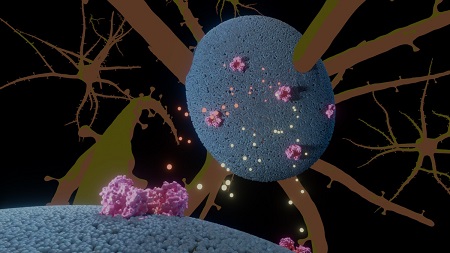Eiwitonderzoek verklaart hoe één mutatie een neurologisch probleem veroorzaakt
Wereldwijd is er amper een handjevol patiënten met de neurologische ziekte Episodische Ataxie type 6, die voorbijgaand verlies van controle over de spieren veroorzaakt. Daarvoor is een mutatie verantwoordelijk die één aminozuur verandert in een eiwit dat een signaalstof door de membraan van zenuwcellen transporteert. Onderzoekers van de Rijksuniversiteit Groningen hebben nu ontdekt hóe de mutatie kan leiden tot dit probleem. Hun resultaten verschenen op 20 maart in het tijdschrift Nature Communications.
Patiënten met ataxie verliezen de controle over spieren, wat bijvoorbeeld gevolgen heeft voor hoe ze bewegen of praten. Een extreem zeldzame vorm hiervan is Episodische Ataxie type 6 (EA6), waarbij patiënten af en toe een aanval van ataxie hebben. Wereldwijd zijn er iets meer dan tien patiënten bekend, inclusief een familie in Nederland. Het is bekend dat de oorzaak van EA6 ligt in een mutatie, maar hoe die zorgt voor zo’n dramatisch effect was een mysterie. ‘Het eiwit transporteert glutamaat over de membraan van zenuwcellen’, legt structuurbioloog Albert Guskov uit. Dat eiwit zit in de celmembraan, en de mutatie zorgt ervoor dat een proline aminozuur is vervangen door een arginine, in een helix-vormig deel van het eiwit dat zich in de membraan bevindt.

Verrassing
‘Een proline in een helix levert een knik op’, aldus Guskov. ‘Als de proline is vervangen door een arginine, verwacht je dat die knik verdwijnt. Om dat te testen hebben we de structuur van het gemuteerde eiwit onderzocht.’ Aangezien de menselijke variant van dit transporteiwit lastig te bestuderen is, gebruikten Guskov en zijn collega’s een vergelijkbaar eiwit uit een archaea, een oude soort eencellige. ‘Dit eiwit is binnen de archaea door de hele evolutie heen ongeveer gelijk gebleven. Uit eerder werk weten we dat het een prima model is voor het menselijke transporteiwit’, vertelt Guskov.
De onderzoekers gebruikten cryo-elektronenmicroscopie om de structuur van normale en gemuteerde eiwitten in een kunstmatig membraan te bestuderen. Eerder had het team al laten zien dat een deel van het eiwit op en neer kan bewegen door de membraan heen, als een lift. Hun hypothese was dat de mutatie de knik in het eiwitdeel dat door de membraan steekt zou doen verdwijnen, wat de vorm van het eiwit aantast en daardoor de werking van de lift blokkeert.
Maar dat bleek niet zo te zijn. Guskov: ‘Tot onze verrassing was de knik gewoon nog aanwezig.’ Desondanks had de mutatie de functie van het eiwit aangetast. ‘De transportsnelheid was met een factor twee gedaald in vergelijking met het gewone eiwit.’ Bovendien vormt het eiwit tijdens transport van aspartaat kortstondig een kanaaltje waar negatieve ionen doorheen komen. ‘En in het gemuteerde eiwit was het ionentransport drie keer hoger.’

Functioneren
Op de een of andere manier veranderde de arginine in plaats van proline niet de vorm van het eiwit, maar wel de werking ervan. Daarom voerden de onderzoekers simulaties van moleculaire dynamica uit, wat alle interacties laat zien tussen de aminozuren van het eiwit met hun omgeving. ‘Daarbij zagen we dat er een zoutbrug ontstond tussen de arginine en de lipiden uit de membraan.’ Die zoutbrug is een aantrekkende kracht tussen moleculen, en bleek de beweging van de ‘lift’ door de membraan te vertragen.
Guskov: ‘Dat de lift trager beweegt verklaart waarom die minder aspartaat transporteert, en het betekent ook dat het ionenkanaal langer open blijft staan, zodat er meer ionen doorheen kunnen stromen.’ In menselijke zenuwcellen zou dit zorgen voor minder transport van de signaalstof glutamaat en een toegenomen onbalans in negatieve ionen. Dat kan het ontstaat van ataxie verklaren. ‘Beide effecten zijn slecht voor het functioneren van zenuwcellen.’
Vragen
Helaas is er geen eenvoudige manier om het effect van de mutatie tegen te gaan. Guskov: ‘Bovendien zit dit transporteiwit overal in het lichaam, dus een geneesmiddel dat daar op inwerkt zal vermoedelijk allerlei bijwerkingen hebben.’ Bovendien zal geen enkele geneesmiddelenfabrikant willen investeren in een medicijn voor een ziekte die slechts enkele tientallen patiënten treft. ‘Al zouden er best meer kunnen zijn’, denkt Guskov. ‘Het is een ziekte die maar af en toe opvlamt, dus mensen zijn zich wellicht niet bewust dat ze dit hebben. Ze zijn er simpelweg aan gewend om zich af en toe een paar dagen niet lekker te voelen, net zoals iemand met migraine.’
Voor wetenschappers roepen de bevindingen enkele interessante vragen op. Guskov: ‘Het eiwit is grotendeels onveranderd gebleven tijdens de evolutie. Dus waarom is dit tijdelijke ionenkanaal ontstaan, en waarom is het blijkbaar zo gunstig voor archaea dat het aanwezig bleef, en zelfs in onze zenuwcellen terecht kon komen? Dat zouden we graag willen begrijpen.’
Referentie: Emanuela Colucci, Zaid R. Anshari, Miyer F. Patiño-Ruiz, Mariia Nemchinova, Jacob Whittaker, Dirk J. Slotboom & Albert Guskov: Mutation in glutamate transporter homologue GltTk provides insights into pathologic mechanism of episodic ataxia 6, Nature Communications, 20 maart 2023
Meer nieuws
-
27 november 2025
Vliegtuigen spotten met een radiotelescoop

